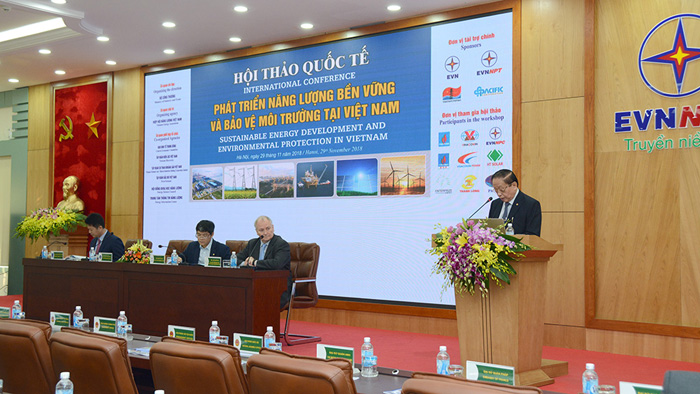At the Conference, Mr. Tran Viet Ngai - Chairman of VEA said that with the current socio-economic development trend, the demand on energy is increasing, the energy sector is required to prepare a step ahead and pursue sustainable development. By 2020, the country would need about 60,000MW of power, this figure in 2030 would be 129,000MW. Thus, Viet Nam needed an additional capacity of 6,000 - 7,000MW per year.
It is necessary to determine the capacity ratio of each power source, appropriate structure, ensuring a balance in stable and sustainable supply of power. After 2030, in total capacity of power sources in Viet Nam, the proportion should be 60% for coal-fired thermal power, 20% for hydropower, 30% for gas-fired power (with LNG) and 20% for renewable energy (including 30% for back up).
However, ensuring energy security for the country in the coming time will face many difficulties and challenges. Actually, from 2015, Viet Nam has shifted from an energy exporter to an energy importer. In the primary energy structure, the rate of energy imports rising to 20% in 2020 will increase to 50% from 2030.
For a long term, the restriction on domestic primary energy sources will lead to an increasing dependence on imported energy.

Mr. Tran Viet Ngai - VEA Chairman delivering speech at Conference.
The representative from Viet Nam National Coal and Mineral Industries Holding Corporation Limited (TKV) said that the domestic demand for coal had rapidly increased, it was expected to reach 150 million tons/year by 2035, while the domestic production was expected to reach only 42 to 50 million tons/year in the coming time. In fact, the Coal sector had only produced about 38 million tons/year.
Meanwhile, the demand for coal is increasing, highly exceeding the supply capacity of the Sector. Particularly thermal power, according to calculation, the demand on coal for power generation in 2020 is 60 million tons, in 2035 is 127 million tons. Therefore, the import of coal is inevitable.
At the Conference, there are many comments that, with the great role of coal-fired thermal power in Vietnamese Power system, solutions should be performed to ensure coal for power generation such as: Looking for long-term partners, investing in coal import infrastructure, etc. The Government should clarify and assign responsibilities for clue of coal import providing for power generation.
Speaking at the Conference, Deputy General Director of EVN Nguyen Tai Anh said that the current situation of the energy sector should be clearly understood in order to propose appropriate solutions. With the increasing demand for power in Viet Nam, attention should be paid to the propagation on power saving, implementation of load management programs, etc., contributing to ensuring energy security.
For coal-fired thermal power accounting for a large proportion in power system, more attention should be paid to environmental issues. Currently, advanced technologies have been applied to treat waste from power plants to protect the environment.
At the Conference, delegates agreed to focus on treating ash, slag, fly ash from coal-fired thermal plants to reuse as building materials, applying technologies to remove NOx, SOx, etc. For the Coal sector, it is necessary to ensure the environment in excavating tunnels, transporting, separating, warehousing, etc.

Deputy General Director Nguyen Tai Anh speaking at Conference.
The Conference also discussed on energy price in Viet Nam, which has not really attracted domestic and foreign investors, while the demand on capital for energy development is very large. Particularly, the requirements for environmental protection have become increasingly strict and rigorous, etc., putting a lot of pressure on ensuring national energy security.
In order to achieve the set targets in the revised Power Master Plan No. VII, Ministries, sectors and Energy groups should review and overcome power projects being in slow progress. At the same time, there should be appropriate pricing mechanisms to attract investors.
Participants also suggested that the use of renewable energy in Viet Nam should be promoted. However, in order to connect high-capacity wind, solar power to the national power system, there should be energy storage system (ESS) or power from liquefied natural gas (LNG), hydroelectric power plants should be constructed to ensure the frequency, voltage, load for the system. Attention should be paid to management moderation method for appropriate operation between renewable and traditional power sources. At the same time, the application of industrial revolution 4.0 in the energy sector should be deployed to ensure sustainable development.